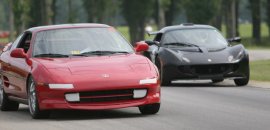JumpFrom TrackpediaJumps can be spectated in rally stages, as well as in stunt driving. It also appears when driving over crests in race tracks. However, there is a bit more to it than simply speeding up and jumping over. First off, the driver needs to see whether he can avoid the jump without having to take a line that is too slow. Sometimes, crests appear on the outside of the tracks just before corners, so it's the driver's choice whether to cross around in a tighter line (generally less recommended), or jump over and turn-in late. In this case, he should be aware of the technique used to negotiate such a crest: First off, should the driver decide to run over the jump, he needs to place the car fully on it, to avoid setting it out of balance by bumping one of it's sides. As said, if the crest comes before a corner, it's best to apply the brakes before it. The idea is, that weight distribution and weight transfers work even as the car is airborne. The driver must consider the bias of his car and his weight transfer. He should enter the jump with a medium speed, and than going on the throttle, especially if the jump is sharp or follows an uphill incline. This should keep the car stable while in the air, due to a gyroscopic effect generated by the spinning tires. It will not nessecarily allow for quicker times, but a right approach to a jump will save on the car and will be a very exciting ordeal. In most jumps, the driver should see a bit of sky, but if he feels he is looking far too vertically, easing off of the throttle completely and re-applying it lightly will help. Braking is not nessecary and not recommended. Needless to say the wheel must be kept straight during this, even in a challenging rally stage. It's best for the driver to brace himself, by taking in a large breath of air, and exhaling just as he is about to jump, so that is he is not winded when he lands. Additionally, take your thumbs outside of the wheel, to avoid the risk (albeit minimal) of thumb fracture. The same approach, by the way (slowing down before, accelerating through) is used in the WRC to negotiate Watersplashes. The power is used to keep the car pitched through the water and especially coming out of it. Coming out of a puddle and back onto a dry surface, will result in the front tires being soaked and thus lack grip. Should the driver corner, this would result in understeer. The unladen rear-wheels would require more time to dry out and could result is slight oversteer. Staying on the gas relieves you from this or from making any steering correction. If the car slightly sways over a crest or puddle, keep the wheel straight untill full grip is regained and than make slight corrections to maintain grip. |
